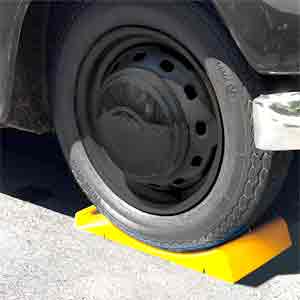Special Care Must be Given to the Tires of Your RV or Tiny Home Trailer
Caring for your tires is an important aspect of tiny living that must not be neglected. I cannot stress enough how important this is.
RV tires usually don’t have a lot of miles on them so the tread does not wear down like a car tire. Instead, RV tires get seriously damaged from the burning rays of the sun. This causes side-wall weather cracking. Take a close look. Even the tiniest cracks are a danger sign.
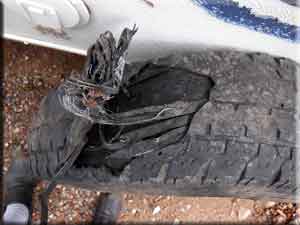
Hidden steel belts gave way and caused catastrophic blow out of this tire.
Long periods of inactivity can cause flat spots. Today’s steel-belted radial ply highway tire is a highly engineered component. The steel belts can sag and lose integrity when sitting in one position and weighted down for long periods (see the tire cradles below). This hidden damage can cause a blowout resulting in the loss of your entire home. The tire shown here is from my RV. I had all my tires inspected at one of the big tire places and we were “good to go,” they said. Less than a hundred miles later: boom. The cheapskate in me wanted to replace only the blown tire but I have learned better. They were the same age, they weathered in the same conditions, and they all needed to be replaced.
RV Tires Will “Time-Out” Before They Wear Out
Because travel trailers and motor homes are driven and used on an occasional basis, the tires will time-out before the tread wears out. The general consensus is that tires need to be replaced every five to seven years whether the tread is worn out or not.
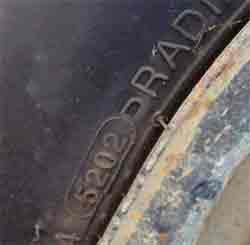 Because RV tires sit still for long periods of time the steel belts inside can migrate, causing the spectacular disintegration of the tires while driving (see the tire cradles below). Besides the possibility of losing control of the vehicle as the tire tears apart, it can damage the underside of the RV.
Because RV tires sit still for long periods of time the steel belts inside can migrate, causing the spectacular disintegration of the tires while driving (see the tire cradles below). Besides the possibility of losing control of the vehicle as the tire tears apart, it can damage the underside of the RV.
Tires have a “date-stamp,” indicating their age. The numbers on this tire, 5202, indicates it was manufactured in the fifty second week of 2002. It needs to be replaced, even if it looks brand new.
Also check your spare tire. The spare tire is frequently overlooked. Mine was nineteen years old when I thought to check it.
RV Tire Inflation Safety Issues
Improperly inflated tires are one of the leading causes of tire blow outs. Being underinflated not only causes uneven wear but also causes the tire to heat up when moving.
High heat can lead to disastrous results if not caught quickly. High ambient temperature and locking breaks can also cause high heat to occur.
Too much weight on your tires is also a leading cause of blowouts.
You may not become aware of tire issues soon enough to prevent a blowout. That’s why we suggest a tire pressure monitoring system (TPMS).
For a great blog on tire pressure safety visit this page of TechnoRV: 3 Safety Issues With RV Tires
Here’s another solid blog for essential tire information: How Do I Determine the Correct PSI for my RV Tires?
Tire Pressure Monitoring Systems
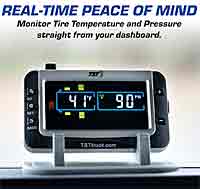
A TPMS system will monitor the tire pressure of each tire. It can notify you with a dedicated display monitor or through an app on your phone. The good TPMS will also keep track of the temperature.
Installation of a TPMS is very easy. You’ll be able to rest easier getting real time data on your tires. Properly inflated tires can also increase your fuel efficiency.
Truck Systems Technology (TST) provides the best Tire Pressure Monitoring System (TPMS) for RVs on the market. The TST 507 color monitor, shown here, alarms you in the event of low pressure, high pressure, rapid pressure loss, slow leaks, and high temperature giving you time to get off the road before a possible blowout occurs.
The TST-507 includes a handy signal repeater, which is particularly useful for setting this system up on a large rig or when towing multiple trailers. The signal repeater helps to amplify the signals produced by your sensors to the system’s display. You can also keep track of your “toad” tires. The kit comes with 4-8 tire cap sensors. Buy enough to attach to each of your tires.
Tires That Fit the Specifications You Need
I bought Light Truck (LT) tires for my motor home, and the ride improvement was remarkable. Because the side walls are stronger than regular passenger car tires, the sway was greatly reduced. The tread is still optimal for traction.
For a travel trailer or 5th wheel you’ll want ST, or Special Trailer tires. These have even stronger side walls to handle the weight of a trailer. The tread design is engineered to provide less resistance for easier towing and better gas mileage. ST tires have larger, stronger polyester cords and strands in the steel belts. The rubber compound is harder, adding to the sidewall strength.
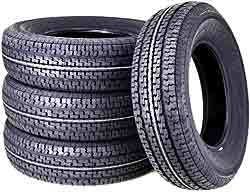
4 Heavy Duty FREE COUNTRY Trailer Tires ST205/75R15 10PR Load Range E Steel Belted Radial w/Scuff Guard
FULL nylon cap ply overlay cross entire tread area, significant upgrade from most other products on the market have nylon strips on shoulder area only, add critical safety feature!. Heavy Duty 10 ply rated, load Range E, Speed rating M up to 81 mp/h. This tire is designed for the trailer use only, rims are not included.
Added benefits of 10-ply tires
Tires with 10-ply and tough side walls reduce sway and rocking while driving. Your towing experience will be a lot better.
Another benefit it less bounce/motion when you are set up at your site.
Tiny Home Trailer Tire Care
- Keep tires covered from sunlight whenever you are not moving. Click on picture of wheel covers to order the ones I recommend.
- Never spray on a “tire preservative.” Using products that contain alcohol, petroleum, or silicone may cause your tires to deteriorate and crack.
- Remove tires or take the weight off when you are staying in one location for more than a few months.
- If you see a bulge or blister on the sidewall, replace the tire at once. These signal potential weak spots that could lead to tire failure.
- When buying a new trailer, make sure the tires are at least “load range E” to support the weight.
- Replace all tires over five years old, even if they look fine.
- Do not buy “retreads” just to save a buck. Buy new light truck tires only.
Why don’t car tires deteriorate like trailer or RV tires?
Tire manufacturers build in a wax, anti-oxidant, and an anti-ozone protection. These chemicals, impregnated in the rubber, migrate to the outer layers of the tire when the tire spins. Tires dry-rot when stored and are not moved frequently, because these additives can not come to the surface of the tire to provide protection.
How to take the weight off your tires
Unweighting your tires on a travel trailer is easy. When you are in the leveling process, lower the front of the trailer as far as the tongue jack will allow. Install your leveling jacks on the rear corners. Next, jack up the front of the trailer as far as it will go. Position the front corner leveling jacks and lower the front of the trailer onto the jacks (or blocks). This should have removed a lot of the weight from the tires. They might even be completely off the ground, which would be best. Use a level to fine tune the height of each jack to provide a level, stable base for your home or RV.
Changing a Tire on a Very Heavy Load
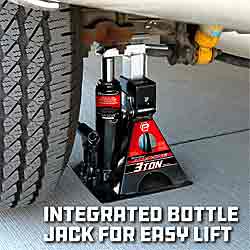
To lift a travel trailer, RV, or tiny house you’ll need a very hefty jack. It doesn’t need to be able to lift the entire rig, but it does need to be able to lift about half the weight.
The Powerbuilt 3 Ton All-in-One UniJack is designed to safely lift and hold the load safely in place. It is composed of the hydraulic bottle jack and a wide based, sturdy jack stand.
This jack lifts 21″ which is far more than most. This is a good thing because RVs, travel trailers, and tiny homes have a lot more ground clearance that cars.
You can set it on 2×8 hunks of wood to get more rise. The wide base keeps it stable. Do be sure to block your tires on the other side though.
You can get bottle jacks that lift more weight, all the way up to 12-tons, but they usually don’t lift as far, only about 10″ so you you’d need to carry a bunch of 2x blocks to get the height.
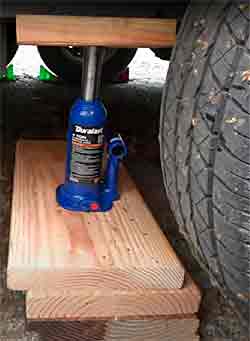
Choose the jack location carefully
Placement of the bottle jack is very important to avoid damaging the travel trailer or motor home.
Motor homes usually have a jack location built into the frame they want you to use. Refer to the vehicle instruction manual for the location.
For a travel trailer or tiny home, pick an area of the frame between the tires. The photo shown here is a screen shot from a good YouTube® video about changing your travel trailer tires.
Do not place the jack under the axles or leaf springs as damage could result.
Use tire cradles to prevent flat spots
To prevent your RV, travel trailer, or tiny home tires from developing flat spots use these tire saver cradles.
Make sure you place one ramp under each tire. If you have dual tires in the rear, place a ramp under each tire so the weight is distributed properly.
The tire cradles shown are a four pack. For most RVs you’ll need to buy the additional two pack too.


